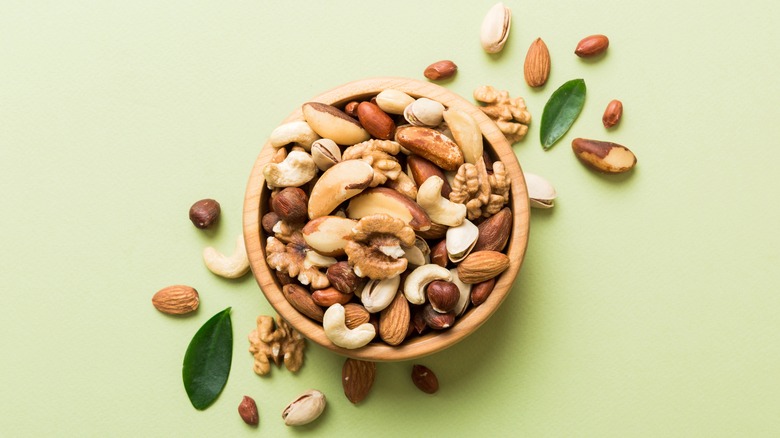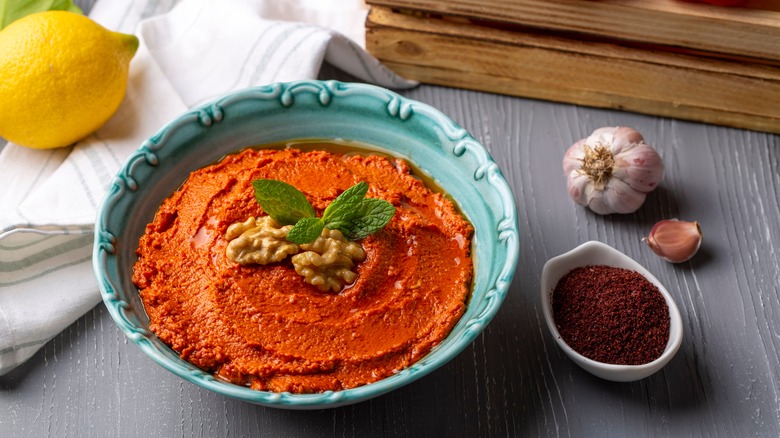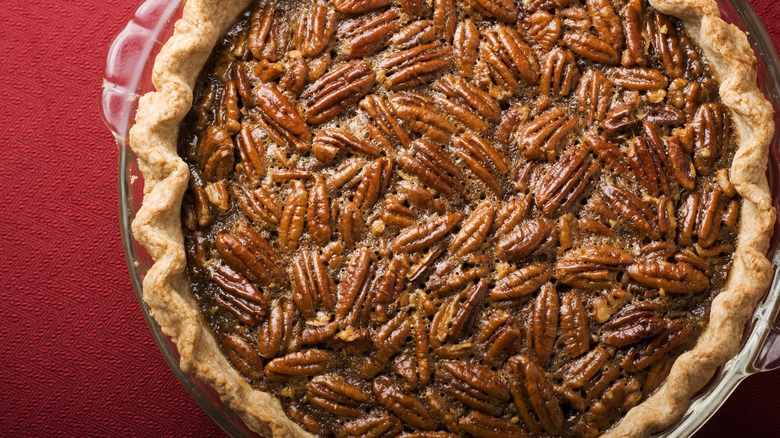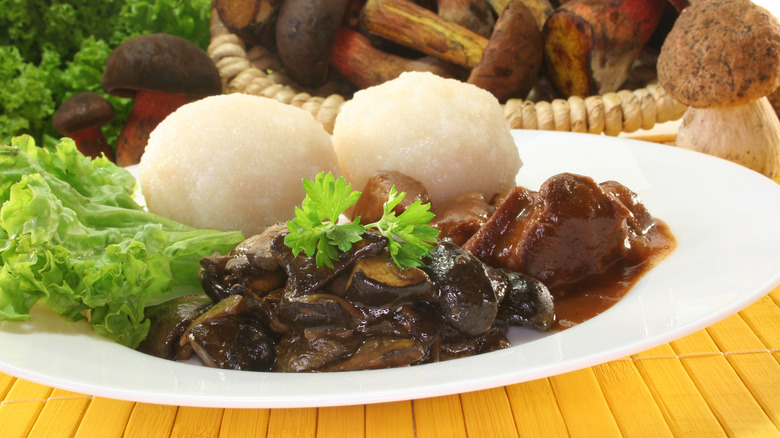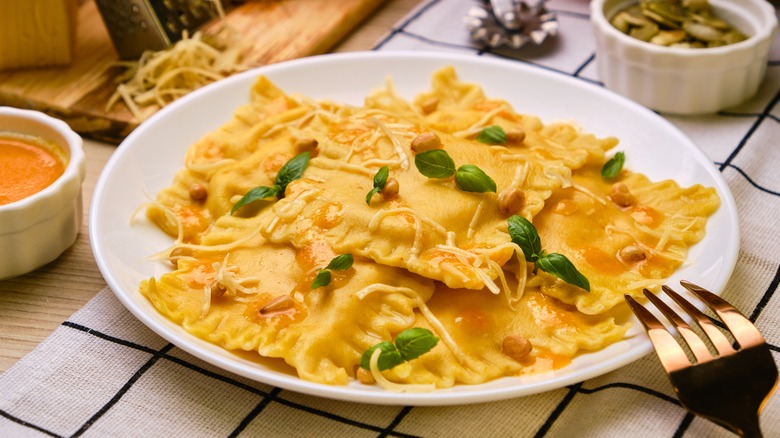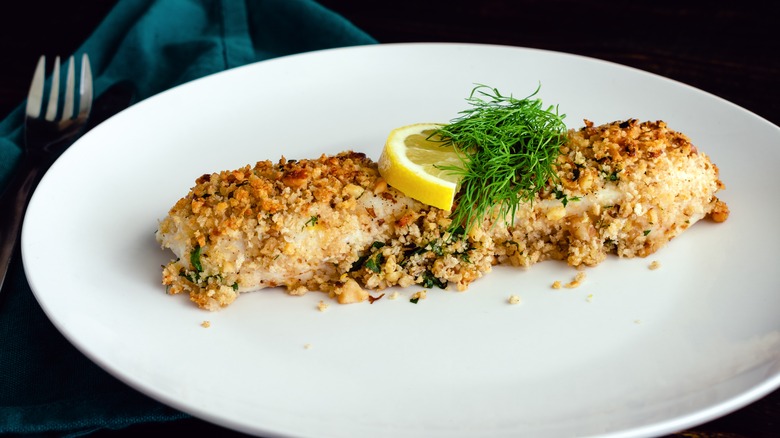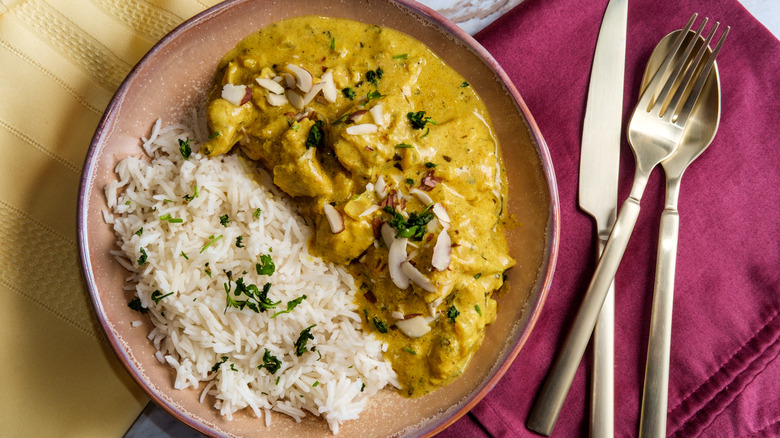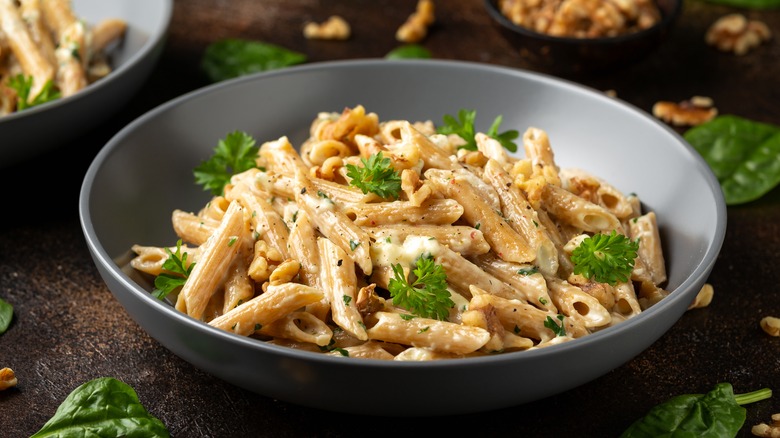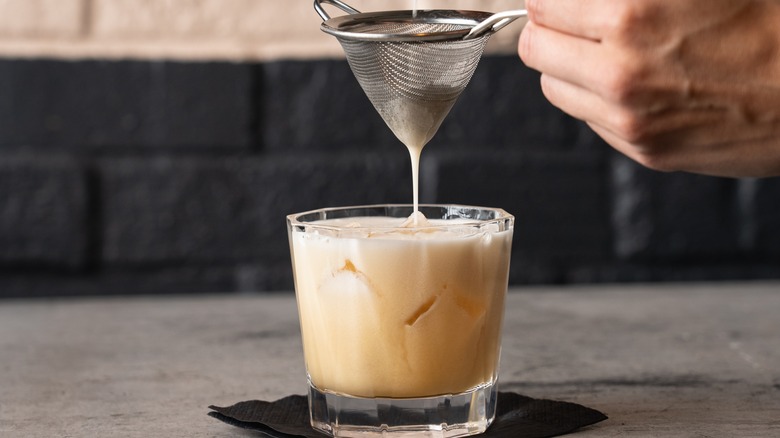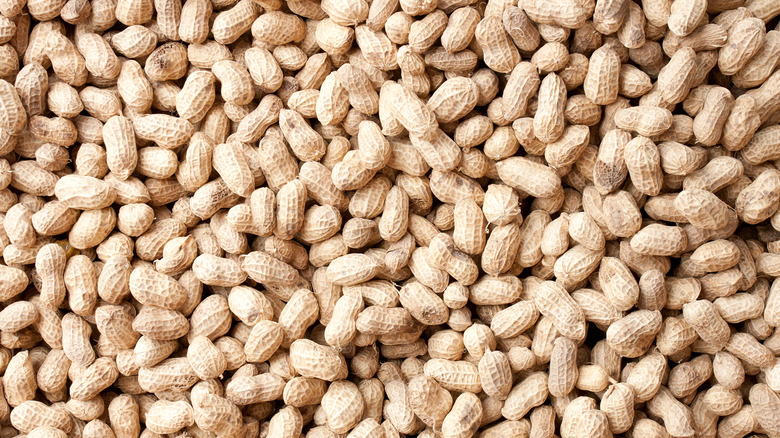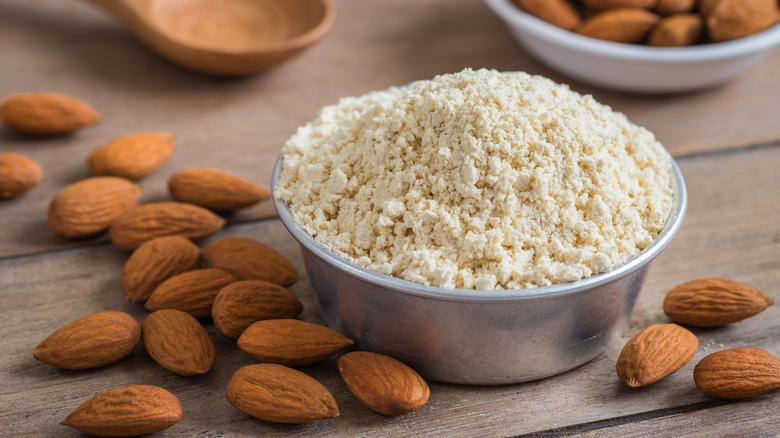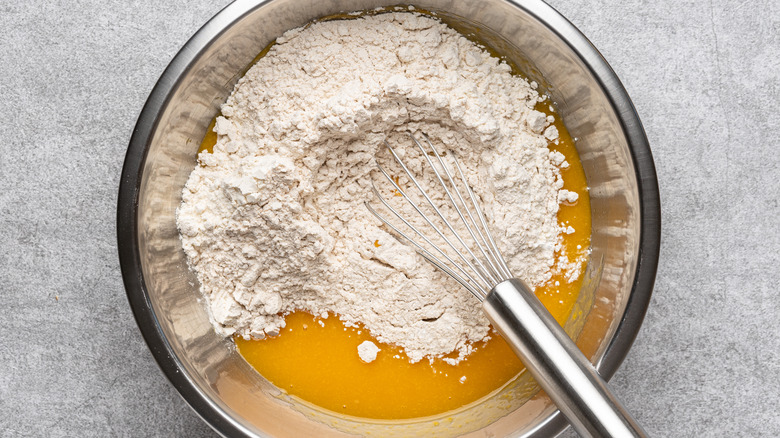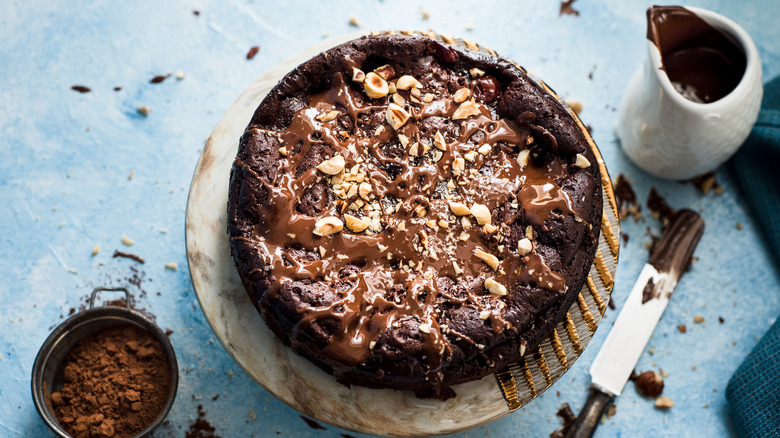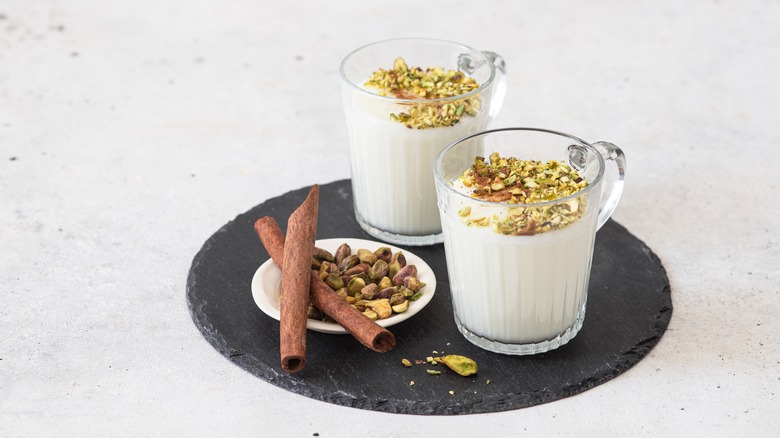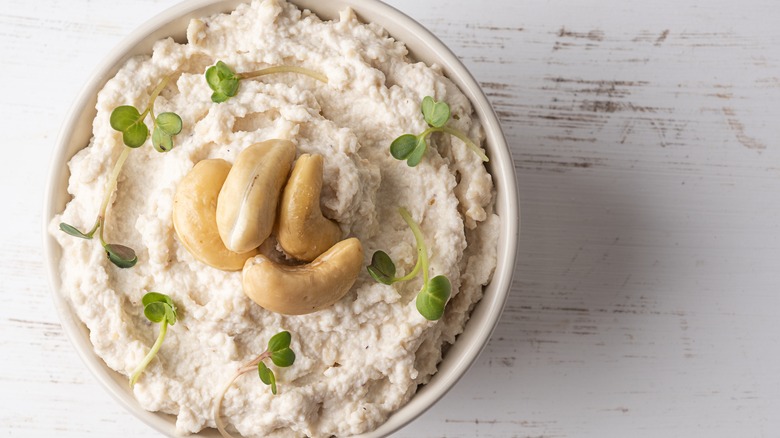14 Delicious And Creative Ways To Use Nuts
Few foods hit the spot like nuts do. These hard, crunchy morsels of food — which are actually a type of fruit – are both versatile and satisfying, slotting into meals at any time of the day and providing you with fiber, protein, and healthy fats. And while we often lump nuts into one category taste-wise, each variety offers a different flavor profile and suitability for use. Almonds, for example, have a gently sweet taste that works well in granola or homemade protein bars, whereas cashews have a creamy, buttery taste that pairs wonderfully with salty, cheesy flavors.
It's all too easy to get bored with nuts, though — and while they're great on their own as a snack or mixed into your breakfast cereal, that's not all they're good for. Nuts can be used in a range of different applications to add extra flavor to dishes while also providing bulk, thickness, and crunch. They're particularly useful for use in place of flour or breadcrumbs or lending their nutty taste to meals in unexpected and exciting ways, either as a topping or incorporated into your recipe.
1. Make a dip out of them
Nuts have a natural creaminess to them, which is supplied by their high-fat content. And this makes them the perfect ingredient for dips. Cashews are the ideal nut to use as a base for dips, as they have a mild, dairy-like flavor with buttery notes that make them perfect as a cheese replacement or paired with stronger, cheesier flavors. Puréed cashews combined with plant-based milk and some nutritional flakes can form a basic vegan queso dip to which you can add all sorts of delicious flavors.
Muhammara, meanwhile, is a popular dip that can be found in several Middle Eastern countries, most specifically Syria. Muhammara combines pulsed walnuts with red peppers, pepper flakes, molasses, and oil to make a sweet, creamy dip with a touch of piquancy. As walnuts have an especially creamy taste, they're also great mixed into other dips like hummus or even tzatziki, where they can add further body and flavor. Pine nuts and pistachios are also excellent chopped up and mixed with hummus, and when toasted, they can give it a depth and warmth that the chickpeas on their own just don't deliver.
2. Use nuts in a pie crust
Pies and nuts are a match made in heaven, but we tend to only use them as a filling. Instead, try incorporating nuts into your pie crust directly, to give the whole dish a super-nutty taste. Nut crusts can be made entirely from nuts, or can be a combination of chopped nuts and flour. A crust made fully from nuts is a great option for folks who are gluten intolerant or are following a low-carb diet, and are usually held together by melted butter or egg whites.
Bear in mind that pie crusts made entirely from nuts will have to be baked before they're ready to be filled, and it's important to keep a close eye on them to watch that they don't burn. Whether you're making the crust just from nuts or combining them with flour, you'll want to make sure that they're chopped as finely as possible, so that your crust doesn't become lumpy or coarse. Folks following a gluten-free diet can also combine chopped nuts with gluten-free flour like rice flour and/or potato starch. Remember, though, that using nuts in a crust can produce a pretty heavy result, so it's a good idea to make your filling as light as possible to balance this out.
3. Throw them into a stew
Stews are designed to be hearty, filling meals that keep you warm during the winter. So, there is really no better ingredient than nuts. Nuts can provide a stew with additional body and give them a deep, nutty flavor, which is especially pronounced when they're toasted beforehand. As well as this, nuts can give stews and casseroles an all-important crunch that can often be missing if they've been simmering for a while and softening their vegetables.
Most nuts tend to work well in a stew, with hazelnuts and flaked almonds both excellent choices. In our opinion, no nuts are better suited for stews than chestnuts. This little-used nut has a soft, somewhat meaty texture and a slightly savory flavor, with just enough crunch for them to retain their body.
Chestnuts work especially well with the deeply savory notes of beef and lamb, as well as bacon, with the salty, fatty meat being tempered by the subtlety of the nut. Because they provide so much body, though, chestnuts can also form the main part of a stew and, when paired with mushrooms and thyme, can produce a vegetarian or vegan main meal that's rich and satisfying.
4. Add pine nuts to your pasta filling
Pretty much anything can be used as a pasta filling, providing that it's chopped finely enough. But it's important to get the balance right. If pasta fillings taste too sharp or spicy, they overwhelm the delicate flavor of the pasta dough itself.
The key is to find variation in your pasta filling ingredients, with some punchier additions like lemon zest or mature cheese combined with a gentler base ingredient. And for this, pine nuts are ideal. Pine nuts, which are actually seeds, have a subtle, creamy flavor with an undertone of nuttiness. They counterbalance any stronger-tasting ingredients while simultaneously providing body to the filling. These seeds also work particularly well with sharp cheeses like feta or goat's cheese, or you can amp up the creamy aspect by mixing them with ricotta.
Pine nuts are also small enough to be used in a pasta filling without much chopping, and because they're not too crunchy, they won't cause any surprises when you bite into them. If you want an extra pop of flavor, try toasting your pine nuts beforehand in a dry pan. The brownness produced gives the pine nuts an additional depth while firming them up slightly.
5. Use chopped nuts as a coating for fish
Sometimes, fish is just better when it's coated. Coating fish, whether in breadcrumbs or batter, gives it a crispy exterior that can't be replicated when cooking it without anything on its outside. The coating also adds flavor to fish and, perhaps most crucially, serves to lock in moistness and natural juices, stopping the fish flesh from drying out when cooked.
And while you can coat fish in many things, we personally love using nuts. Encasing your fish in a nut crust adds some well-needed fat to otherwise-lean white fish fillets and gives them a nutty, creamy flavor. For nut-crusted mahi-mahi, try chopped macadamia nuts combined with Panko breadcrumbs to coat your fish. The macadamia nuts will give the fish a slight sweetness and nuttiness, while the Panko breadcrumbs will amp up the crunch.
If you follow a gluten-free diet, you can swap out Panko breadcrumbs for gluten-free breadcrumbs. You can also skip using breadcrumbs entirely and opt for a full nut coating. Just bear in mind that breadcrumbs don't just give crunch but act as a binder for the crust, and solely using nuts may mean that your fish has a slightly patchy coating in certain areas.
6. Toss them into a curry
Curries and nuts are a match made in heaven, and you may have already had a nut-filled curry without realizing it. Cashew nuts and ground almonds are often used in korma recipes. They can frequently be incorporated in their ground form to thicken the gravy and provide a nutty flavor, disappearing seamlessly into the sauce. Elsewhere, flaked almonds can often be found in biryanis, and peanuts, both in chopped and whole form, are stirred into all manner of curries.
But there's no reason to only stick to these uses. The truth is that any nut can be added to curries, either in ground, chopped, or whole form, where they add bite and crunch. Nuts are especially well-suited to vegetarian or vegan curries, supplying them with body. Ingredients derived from nuts, like cashew cream, can also be used to give these curries creaminess without having to rely on dairy products.
In meat-based curries, too, nuts work well, helping to balance the savory tastes of red meat in particular. Try stirring some flaked almonds into a lamb rogan josh or throwing a handful of cashews into a beef massaman curry.
7. Make a pasta sauce from nuts
Pasta and nuts are paired together more often than you might think. Pine nuts form the basis of pesto, one of the most widely available pasta sauces. And these can be subbed out for virtually any type of nut, with different choices giving your pesto a different flavor.
But you shouldn't just stop at pesto. Nuts can be a central component of many different types of sauce, where they add richness and satisfying crunch. If you have any walnuts on hand, try making an anchovy-walnut sauce by toasting them and then frying them alongside the salty fish, some garlic, and some vegetable broth. The sharpness of the anchovies is undercut by the walnuts, with the whole thing coming together to make a light yet flavorful sauce.
Nuts can also be used to replicate cream-based sauces without the need for any cream. Cashew cream makes an especially good substitute for heavy cream. It can be used to make a pretty special vegan alfredo sauce by combining it with nutritional yeast, lemon juice, and garlic. You can even toss in some vegan mozzarella, if you like, for that cheese-pull effect when you twirl your pasta.
8. Use chopped nuts to rim your cocktails
Chopped nuts aren't just great additions to food — they're also a great addition to drinks. Finely chopped nuts can make an excellent garnish for cocktails and look particularly elegant when dusted around the rim of a glass. Chopped nuts make a great rim decoration for any cocktails using a nut liqueur – and there are quite a few to choose from.
You can amp up the almondy taste of an amaretto sour by sprinkling the rim of your glass with chopped almonds or do the same with hazelnuts for a Frangelico sour. Alternatively, try making yourself a cocktail with Bottega pistachio liqueur, combining it with vodka and a drop of absinthe, and rimming your glass with some bright-green ground pistachios.
Rimming your glass with nuts is also a distinctly festive touch and can give any Christmas-themed cocktails or drinks a further feeling of warmth and coziness. Your customary glass of eggnog, for example, can be improved to no end by serving it in a glass rimmed with ground cashews, and a creamy White Russian can get even more creamy when topped with finely chopped almonds or pistachios.
9. Make a salsa from peanuts
Adding nuts to your salsa is not something we normally think to do, but peanuts, in particular, can be used to make a salsa de cacahuate, or peanut salsa. This salsa is especially popular in parts of Western Mexico, like Colima, with regional variations incorporating different flavors and spice levels. The Western style is a slightly simpler affair, combining onions and garlic with charred arbol chiles, giving the salsa a kick of heat. In other regions, fire-roasted tomatoes can be added to provide the salsa with extra depth.
Once all the ingredients are fried together, the salsa is then blended until smooth. The final result is like a thin, spicy peanut butter, which is then garnished with chopped peanuts to add further flavor and flair. Salsa de cacahuate can be served with pretty much anything, but it goes especially well with fried or roasted meats, giving them a nutty, spicy, complex taste. It's just as good, though, drizzled over tacos, served with tortilla chips as an appetizer, or even spooned over a fresh, zingy salad.
10. Try ground nuts for thickening sauces
There are many ways to thicken sauces, but not all of them suit every dietary need. While flour can thicken sauces effectively, it's unsuitable for people who can't eat gluten. Starches, meanwhile, may be gluten-free, but they also add carbohydrates to a meal, and so can be problematic for folks who maintain a low-carb or keto diet.
Ground nuts are particularly good at thickening sauces as they tend to absorb liquid when they're added, giving your stews or soups extra body and thickness. Nutritionally, using nuts to thicken sauces is also a great way to add additional protein, fat, and fiber. While flour and starches are largely flavorless, ground nuts can give your sauces an earthiness and mellow flavor that bolsters many foods, both sweet and savory.
You can use virtually any type of nut to thicken a sauce, provided that it's been ground up enough. If you want to make your sauce extra-luscious, grind your nuts down until they're a paste-like consistency. This will stop any grainy pieces of nut lurking in your mixture and keep things smooth.
11. Use them as a flour alternative
There are many ways to bake with nuts. But if you want to go all-out, try replacing your flour with them. Nut flours are gluten-free alternatives to regular flour, which can provide your cakes and bakes with extra moisture and tenderness. This is thanks to the higher fat and water content that nuts have, which imbue your baked goods with a juiciness that you don't need extra wet ingredients.
Nut flour can be made from almost any nut, but almond flour tends to be the most common. The gently sweet, slightly earthy notes of the flour can give your bakes an extra dimension of flavor. While it can be tempting, though, to make cakes entirely from nut flour, it's advised that you always mix it with regular, gluten-free flour.
Using solely nut flour can produce a bake that's way too heavy and unwieldy and tastes way too rich. Nut flour can also clump easily when it's introduced to your wet goods, so cutting it with regular flour is a good way to balance the extra flavor with a consistency that you'll recognize.
12. Chopped nuts make the perfect cake decoration
You can decorate a cake with pretty much anything, but ideally, you'll want a topping that simultaneously provides flavor and visual appeal. And there are few better options than chopped nuts. Nuts provide a subtle taste to the outside of your cakes, which won't get in the way of your primary flavors in the way that ultra-sugary sprinkles or candy pieces sometimes do. Instead, they give your cakes a light earthiness that helps to cut through the sweetness.
There's also no better way to match the flavors of your cake with your coating. Got a coffee and walnut cake? Coat it with chopped walnuts to amp up the taste. Making a cake with marzipan? Stud it with some flaked almonds to mirror it. The possibilities are endless.
The best part about decorating with chopped nuts is that you can cut them to pretty much any size you want, and provided that your frosting is sticky enough, they'll still look and taste great. The only thing we'd recommend is avoiding nuts that are too finely chopped. When this happens, some types of nuts can become pretty paste-like, and instead of providing crunch, they'll give your cake a gluey consistency.
13. Add them to your hot drinks
Although milk alternatives based on nuts, like almond and cashew milk, have become ever-more popular, we tend not to use whole nuts in our drinks very often. But there's no reason why you can't. Chopped nuts can make an excellent garnish for hot drinks and give them a nutty taste and a comforting feeling.
One particular favorite of ours is sahlab, a thickened milk drink popular in the Middle East. Milk, or a dairy-free milk alternative, is simmered with cornstarch and then sweetened and flavored with maple syrup, orange blossom and rose waters, and cinnamon. It's then topped with crushed pistachios. The thickness of the drink means that the pistachios rest on top of it and form a crunchy topping, which also gives the beverage extra flavor.
There's no reason to stop there, though. Virtually any thick, hot drink can be topped with nuts. Next time you make yourself a cappuccino, try topping it with finely chopped almonds tossed in chocolate powder. A classic hot chocolate can be made even more delicious with some chopped hazelnuts, which pair perfectly with the chocolate flavors. We'd bet that pumpkin spice latté would taste even better with some finely chopped nuts, too.
14. Make cheese out of your nuts
When people start following a plant-based diet, cheese can be one of the things they find hardest to give up. But luckily, there's an easy replacement, and it comes in nut form. Nuts can be used to make excellent plant-based cheese alternatives, and in some cases, they're indistinguishable from the real thing. Nut-based cheeses also offer several dietary advantages to regular cheese, as they're generally lower in sodium and saturated fat.
While you can use several different types of nuts to make cheese, cashews are the best choice. "They have a mild buttery taste and when blended they get so magically creamy and smooth," says Vtopian Artisan Cheeses owner and operator Stiner via Live Kindly.
Once they've been blended, additional ingredients like vegan probiotics or miso paste can be added to the nuts to give the cheese a developed, funky flavor. Vegan cheeses are also often flavored with lemon juice or apple cider vinegar to give them tang or paprika to give them a smoky taste, and nutritional yeast is often added in to give them cheesy notes. While making your own nut-based cheese sounds daunting, it's actually pretty easy to do at home — all you need is a blender, some ingredients, some patience, and a willingness to try something new.
